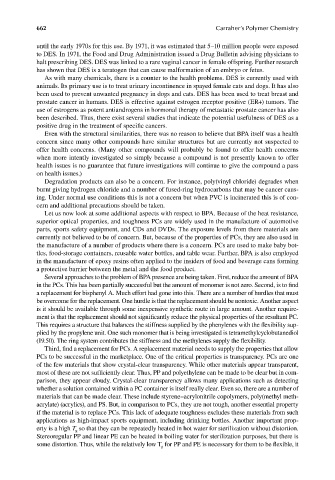Page 699 - Carrahers_Polymer_Chemistry,_Eighth_Edition
P. 699
662 Carraher’s Polymer Chemistry
until the early 1970s for this use. By 1971, it was estimated that 5–10 million people were exposed
to DES. In 1971, the Food and Drug Administration issued a Drug Bulletin advising physicians to
halt prescribing DES. DES was linked to a rare vaginal cancer in female offspring. Further research
has shown that DES is a teratogen that can cause malformation of an embryo or fetus.
As with many chemicals, there is a counter to the health problems. DES is currently used with
animals. Its primary use is to treat urinary incontinence in spayed female cats and dogs. It has also
been used to prevent unwanted pregnancy in dogs and cats. DES has been used to treat breast and
prostate cancer in humans. DES is effective against estrogen receptor positive (ER+) tumors. The
use of estrogens as potent antiandrogens in hormonal therapy of metastatic prostate cancer has also
been described. Thus, there exist several studies that indicate the potential usefulness of DES as a
positive drug in the treatment of specifi c cancers.
Even with the structural similarities, there was no reason to believe that BPA itself was a health
concern since many other compounds have similar structures but are currently not suspected to
offer health concerns. (Many other compounds will probably be found to offer health concerns
when more intently investigated so simply because a compound is not presently known to offer
health issues is no guarantee that future investigations will continue to give the compound a pass
on health issues.)
Degradation products can also be a concern. For instance, poly(vinyl chloride) degrades when
burnt giving hydrogen chloride and a number of fused-ring hydrocarbons that may be cancer caus-
ing. Under normal use conditions this is not a concern but when PVC is incinerated this is of con-
cern and additional precautions should be taken.
Let us now look at some additional aspects with respect to BPA. Because of the heat resistance,
superior optical properties, and toughness PCs are widely used in the manufacture of automotive
parts, sports safety equipment, and CDs and DVDs. The exposure levels from there materials are
currently not believed to be of concern. But, because of the properties of PCs, they are also used in
the manufacture of a number of products where there is a concern. PCs are used to make baby bot-
tles, food-storage containers, reusable water bottles, and table wear. Further, BPA is also employed
in the manufacture of epoxy resins often applied to the insiders of food and beverage cans forming
a protective barrier between the metal and the food product.
Several approaches to the problem of BPA presence are being taken. First, reduce the amount of BPA
in the PCs. This has been partially successful but the amount of monomer is not zero. Second, is to fi nd
a replacement for bisphenyl A. Much effort had gone into this. There are a number of hurdles that must
be overcome for the replacement. One hurdle is that the replacement should be nontoxic. Another aspect
is it should be available through some inexpensive synthetic route in large amount. Another require-
ment is that the replacement should not significantly reduce the physical properties of the resultant PC.
This requires a structure that balances the stiffness supplied by the phenylenes with the fl exibility sup-
plied by the propylene unit. One such monomer that is being investigated is tetramethylcyclobutanediol
(19.50). The ring system contributes the stiffness and the methylenes supply the fl exibility.
Third, find a replacement for PCs. A replacement material needs to supply the properties that allow
PCs to be successful in the marketplace. One of the critical properties is transparency. PCs are one
of the few materials that show crystal-clear transparency. While other materials appear transparent,
most of these are not sufficiently clear. Thus, PP and polyethylene can be made to be clear but in com-
parison, they appear cloudy. Crystal-clear transparency allows many applications such as detecting
whether a solution contained within a PC container is itself really clear. Even so, there are a number of
materials that can be made clear. These include styrene–acrylonitrile copolymers, poly(methyl meth-
acrylate) (acrylics), and PS. But, in comparison to PCs, they are not tough, another essential property
if the material is to replace PCs. This lack of adequate toughness excludes these materials from such
applications as high-impact sports equipment, including drinking bottles. Another important prop-
erty is a high T so that they can be repeatedly heated in hot water for sterilization without distortion.
g
Stereoregular PP and linear PE can be heated in boiling water for sterilization purposes, but there is
some distortion. Thus, while the relatively low T for PP and PE is necessary for them to be fl exible, it
g
9/14/2010 3:44:10 PM
K10478.indb 662
K10478.indb 662 9/14/2010 3:44:10 PM

